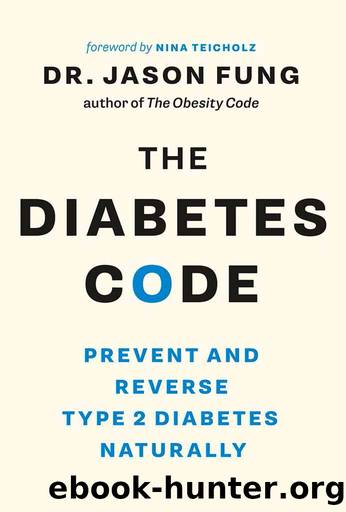The Diabetes Code: Prevent and Reverse Type 2 Diabetes Naturally by Jason Fung

Author:Jason Fung
Language: eng
Format: azw3
Tags: Health & Fitness, Diseases, Medical, Alternative Therapies, Weight Loss, Diet & Nutrition, Diabetes
ISBN: 9781771642668
Publisher: Greystone Books
Published: 2018-04-02T22:00:00+00:00
Atherosclerosis and cardiovascular disease
WHILE TYPE 2 diabetes is associated with numerous complications, including nerve, kidney, and eye damage, the morbidity and mortality associated with cardiovascular diseases is the most important.21 Simply put, most diabetic patients die of cardiovascular disease. As early as 1949, animal studies demonstrated that insulin treatment causes early atherosclerosis, also called hardening of the arteries, which is a precursor to heart attacks, strokes, and peripheral vascular disease. Insulin facilitates every single step along the inflammatory pathway that marks the progression of the disease, including initiation, inflammation, foam cell (fat-laden cell) formation, fibrous plaque formation, and advanced lesions.22 Moreover, fibrous plaque contains insulin receptors,23 and insulin stimulates the growth of plaque, which accelerates the atherosclerosis and substantially raises the risk of cardiovascular disease. Experimentally, these same studies showed that preventing the excessive insulin could reverse the condition.24
If you are not on diabetes medications, the risk of heart disease increases with the degree of hyperglycemia.25 Insulin lowers blood glucose, so it has always been assumed it would protect against disease. But that is only true if glucotoxicity causes the heart disease, which it does not. What has not generally been appreciated is that, if you are not on diabetes medications, the degree of hyperglycemia reflects the severity of diabetes. Trading insulin toxicity for glucotoxicity is not obviously beneficial.
The UK General Practice Database identified more than 84,000 newly diagnosed diabetics between 2000 and 2010.26 Treatment with insulin did not lower heart disease risk; rather, it more than doubled the risk of death. The same held true for heart attacks, strokes, cancer, and kidney disease. Insulin could reduce blood glucose but not heart disease or death.27 Patients with an A1C blood glucose level of 6.0 percent, which was considered excellent control, fared just as poorly as those patients with an A1C of 10.5 percent, which is considered uncontrolled diabetes.28 Ultimately, heavy-handed use of insulin could reduce glucotoxicity, but only at the expense of insulin toxicity. As in type 1 diabetes, high insulin doses were not good; they were bad.
Figure 10.2. Insulin use and increased risk of mortality in type 2 diabetes29
Download
This site does not store any files on its server. We only index and link to content provided by other sites. Please contact the content providers to delete copyright contents if any and email us, we'll remove relevant links or contents immediately.
| ASVAB | GED |
| GRE | NCLEX |
| PRAXIS | SAT |
| See more | Flash Cards |
| Study Guides | Study Skills |
| Workbooks |
Talking to Strangers by Malcolm Gladwell(11859)
The Compound Effect by Darren Hardy(7544)
The Lover by Duras Marguerite(7109)
Wonder by R. J. Palacio(7048)
Tools of Titans by Timothy Ferriss(6934)
The Circle by Dave Eggers(6248)
A Court of Wings and Ruin by Sarah J. Maas(6056)
Kaplan MCAT General Chemistry Review by Kaplan(6044)
Deep Work by Cal Newport(5451)
To All the Boys I've Loved Before by Jenny Han(5176)
Wiseguy by Nicholas Pileggi(4581)
1,001 ASVAB Practice Questions For Dummies by Powers Rod(4034)
The Body: A Guide for Occupants by Bill Bryson(3788)
Barron's AP Biology by Goldberg M.S. Deborah T(3627)
Cracking the GRE Premium Edition with 6 Practice Tests, 2015 (Graduate School Test Preparation) by Princeton Review(3590)
ACT Math For Dummies by Zegarelli Mark(3558)
Eat That Frog! by Brian Tracy(3505)
Kaplan MCAT Organic Chemistry Review: Created for MCAT 2015 (Kaplan Test Prep) by Kaplan(3418)
Pre-Suasion: A Revolutionary Way to Influence and Persuade by Robert Cialdini(3404)
